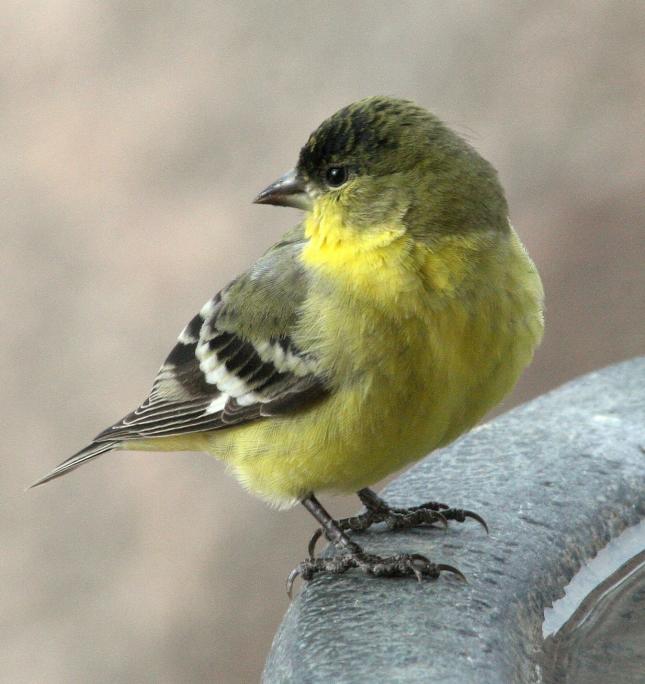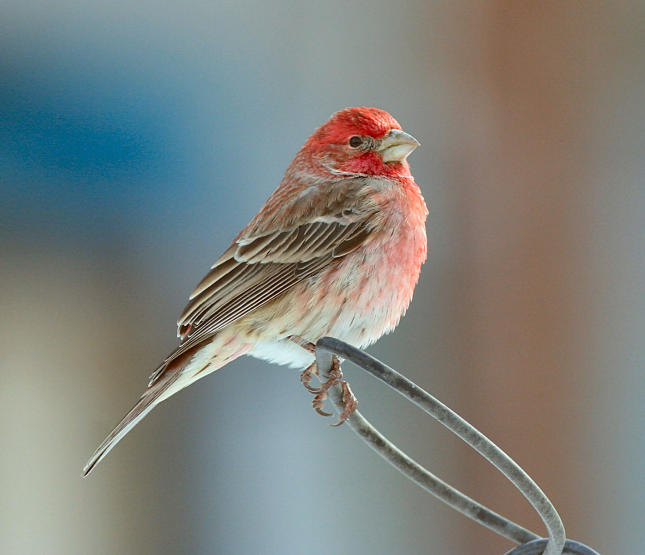Project FeederWatch 2024-25
 It's that time of year again: Project FeederWatch 2024-25 begins Nov. 1 and runs from November 1 through April 30.
It's that time of year again: Project FeederWatch 2024-25 begins Nov. 1 and runs from November 1 through April 30.
FeederWatch is a simple, fun citizen-science project of counting the birds that visit your yard and feeders. You count for just an hour or so for a couple of days each week. Nevertheless, it is one of the most powerful tools that bird scientists have to understand what is happening with all the birds in North America.
FeederWatch seems made for Southern Californians. We can watch our feeders without freezing in the process, and it gets us out of our houses for an hour or two, even if the sun isn't shining. But, if you would rather count from indoors, that's OK too.
Left: A Lesser Goldfinch pauses on a birdbath by David F. Smith, Project FeederWatch
Here's how it works:
Join as soon as possible at https://feederwatch.org/about/how-to-participate. It may take a few weeks for your print materials to arrive. Still, you can begin counting right away.
Select Your Site
Choose a portion of your yard that is easy to monitor, preferably an area that is visible from one vantage point. Even if you don’t have feeders, you still can count birds for FeederWatch. You don't have to count outdoors. A window with a good view can be a great counting site.
 Choose Your Count Days
Choose Your Count Days
FeederWatch asks that you count two days in a row each week, any two days and for as long as you want. For example, you could count on Thursday and Friday from 3:30 to 4. FeederWatch recommends that you leave at least five days a week when you do not count between each of your two-day counts. If it's difficult for you to set a schedule, counting less often is fine. Even if you count only once all season, your data are valuable.
Right: A Cedar Waxwing stretches for a berry by Laura Frazier, Project FeederWatch
How To Count Birds -- For every species you can identify, record the maximum number of individuals visible simultaneously. For example, if, when you start your count, you see two House Finches and one Goldfinch, count those. Then a while later, if you see six House Finches and two Goldfinches. So, change the number of House finches to six and Goldfinches to two. Don't total up your daily counts. Also, count all the birds that are attracted to the feed that you provide, even if they don’t visit the feeders, and ignore birds that simply fly over your count site. At the end of the two days, report the maximum number of each species that you saw simultaneously.
Optional Additional Data – There are several types of additional information you can record and submit with your bird counts:
1) Mammals that you see in your count site (squirrels, etc.)
2) Sick birds and bird mortality
3) Behavioral interactions and predation events (hawk attacks)
4) Management activities that you do at your site (refilling feeders, changing the type of bird food)
5) Feelings about things you see during your counts.
Report Your Counts
Submit counts at the Your Data section of the FeederWatch website or use the FeederWatch mobile app.

All Counts Are Important
FeederWatch participants sometimes stop counting their birds because they believe that their counts are not important. Sometimes you see the same birds every week, or very few or no birds. Keep counting! That data is just as important or maybe more important than any unusual or rare birds you see.
Most of the time you will see low numbers of “predictable” birds. Don't worry. These counts are the heart of FeederWatch. Focusing on the “exciting” visitors would provide a biased view of bird populations.
While we all are thrilled by unusual sightings and high counts, it’s your everyday observations of common birds that are critical for monitoring bird populations.
Left: A male House Finch perches proudly, By Maria Corcacas, Project FeederWatch

